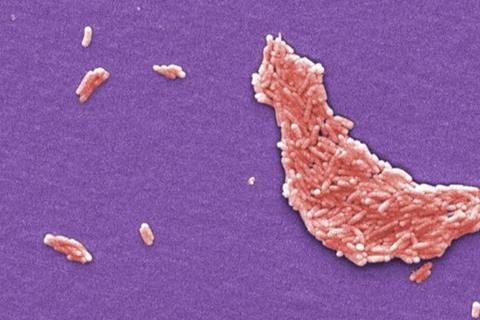A bacterial signaling molecule involved in flipping the switch between sessile and motile forms could offer huge potential in improving probiotics, boosting wastewater treatment and producing therapeutic compounds.

A new review by the research team that re-discovered the ubiquitous bacterial second messenger cyclic di-GMP in 2004 outlines the many ways in which a deeper knowledge of the molecule embedded in the associated signaling pathways could be exploited to transform biotechnology and medical techniques.
The review, entitled ‘’Impact and applications of cyclic di-GMP second messenger signaling in biotechnology and medicine’, appears in Sustainable Microbiology, an Applied Microbiology International publication.
Switch regulator
Corresponding author Ute Römling, Professor of Medical Microbial Physiology at the Karolinska Institutet in Sweden, explains that in 2004 she and her research group re-discovered cyclic di-GMP (Simm R et al., Mol Microbiol, 2004) and innovatively proposed its role as a ubiquitous lifestyle regulator of the switch between sessility and motility at the single cell level.
“Subsequently we were also able to demonstrate that cyclic di-GMP mediates the switch between acute and chronic virulence/commensalism in the gastrointestinal pathogen Salmonella typhimurium. These lifestyle switches, directed by cyclic di-GMP, have been demonstrated in all bacterial models in which the role of cyclic di-GMP has been investigated,” she said.
“Besides these fundamental principles, cyclic di-GMP also directs many associated phenotypes from photosynthesis to antimicrobial tolerance.”
Potential applications
In the latest review, Professor Römling set out to summarise and demonstrate the potentially beneficial roles and application of the ubiquitous bacterial second messenger cyclic di-GMP molecule in biotechnological and medical applications.
The review recapitulates the determinative role of cyclic di-GMP in biofilm formation which predestinates the cyclic di-GMP signaling system and its individual components as target(s) for anti-biofilm approaches (as biofilm formation is the predominant virulence factor in chronic infections of many pathogens).

She also describes early findings that point to cyclic di-GMP signaling offering a target for the design of better probiotics, as well as showing a role as a determinative factor in efficient wastewater treatment via promotion of the formation of stress-tolerant cell aggregates, waymarking a route to more efficient sanitation procedures through research into regulation.
Real-world challenges
The review flags up a number of real-world challenges that have the potential to be tackled with research into cyclic di-GMP, including:
- biofilm formation as the cause of chronic infections
- biofilm formation of beneficial microbes might lead to more efficient probiotics
- optimize strategies for production of antimicrobials by previously cryptic biosynthesis operons
- optimization of efficient degradation of xenobiotics by stress tolerance biofilms
- develop efficient strategies for micro- and nanoplastic degradation by microbial biofilms
- improve efficiency in bioelectrochemical systems
- knowledge about regulation of cyclic di-GMP signaling in industrially used microbes (as flocculants, in waste water treatment, in flotation) might lead to optimized strategies for such applications
- cyclic di-GMP signaling can be used to optimize yield and structure of cyclic di-GMP based materials like exopolysaccharides such as cellulose
- cyclic di-GMP and other cyclic di-nucleotides have been recognized as immunestimmulatory (adjuvants) and as compounds to combat cancer (due to their immunostimulatory and growth inhibiting properties).
- cyclic di-GMP and other cyclic di-nucleotides have been recognized as signaling molecule upon phage infections which can aid the design of rationalized antimicrobial strategies
Ubiquitous molecule
Professor Römling said that one thing that has surprised her is just how ubiquitous cyclic di-GMP signaling proved to be.
“I have been the PI who led the study from the start - the -re-discovery of cyclic di-GMP, setting up the hypothesis of the lifestyle switch and follow-up investigations,” she said.
“But when I re-discovered it, genome sequencing was still in its infancy and functions of many involved proteins not know. Thus the full impact of the discovery was not obvious.”
Highly flexible
The discoveries since 2004 have revealed that cyclic di-GMP signaling is a highly flexible signaling system. Bacteria readily use the system to adapt to their new environment(s), for example use system modifications to promote their acute virulence, such as by downregulating/adapting the system as invasive Shigella do or, in the other direction, balance acute virulence against environmental survival by promoting cyclic di-GMP signaling for enhanced resistance against stresses as Salmonella can do, she said.

One future direction for researchers, she suggested, would be carrying out investigations to understand in more detail the cyclic di-GMP signaling network in flocculating microbes, potentially optimising industrial processes.
Over the years, Professor Römling’s work on cyclic di-GMP signaling has been supported by the Swedish Research Council for Natural Sciences and Engineering, by the European Commission, KI Infection Biology Network and by the Carl Trygger Foundation.
‘Impact and applications of cyclic di-GMP second messenger signaling in biotechnology and medicine’ is published in Sustainable Microbiology.
Topics
- Applied Microbiology International
- Bacteria
- Biofilms
- Clean Water
- Community
- cyclic di-GMP
- Ecology
- Infection Prevention & Control
- Karolinska Institutet
- Microbial Biotechnology
- motile
- One Health
- Probiotics, Prebiotics & Synbiotics
- Salmonella Typhimurium
- sessile
- UK & Rest of Europe
- Ute Römling
- Wastewater & Sanitation
- Whole genome sequencing







No comments yet